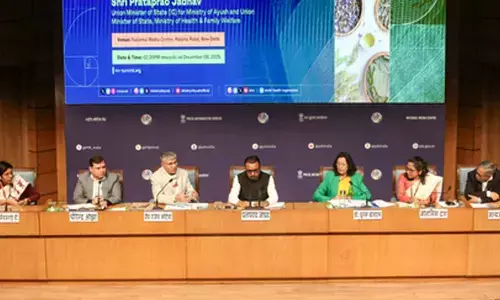Mulugu: Vagaries of nature take sheen off ancient shrine

Vagaries of nature take sheen off ancient shrine
The centuries-old Devunigutta shrine that resembles Cambodia’s largest religious monument Angkor Wat and the sculptural elegance of Java’s Borobudur which is in grave danger of slipping into oblivion due to vagaries of nature and authorities’ neglect is up against a new set of problems recently
Mulugu: The centuries-old Devunigutta shrine that resembles Cambodia's largest religious monument Angkor Wat and the sculptural elegance of Java's Borobudur which is in grave danger of slipping into oblivion due to vagaries of nature and authorities' neglect is up against a new set of problems recently.
The temple, believed to be built in the 6th – 7th century AD by Vishnukundins who ruled the Deccan, has become a subject of invasion for the treasure hunters. With the temple is located in the thick foliage secluded from the reach of the people, the miscreants, hopeful of finding a treasure trove, dug up trenches around it.
With no one to look after it and visitors too abandoning it since the Covid-19 pandemic, it has become tough to access the temple due to the overgrowth of vegetation. With the Agency receiving a record rainfall this monsoon, the trenches dug around the temple by the treasure hunters have turned out to be harvesting pits.
Aravind Arya Pakide, Warangal-based history buff and writer, who recently visited the Devunigutta temple, told The Hans India: "With the authorities concerned turning a blind eye, the sculpted sand rock bricks of the temple which temple represents a distinct amalgamation of both Buddhist and Saivite traditions is in ruins.
The trenches dug around the temple by the treasure hunters and marauders were filled with rainwater and it likely to endanger the foundation of the temple. By far the oldest temple in the region is losing its sheen fast. The entire temple gopuram (tower) is balanced on just 2 cm of wood near the lintel which can collapse any moment, he said.
Aravind also wrote a letter to Union Minister of State for Tourism and Culture Prahlad Singh Patel urging him to take necessary measures to renovate and restore the rare monument by the Archaoelogical Survey of India (ASI). He also sought the ministry to take up the research and documentation work on Devunigutta temple by the State Archaeological Department.
Since the temple came to limelight in 2015, several archaeologists from Germany, US and Italy have visited the temple. Among them are… Phillip B. Wagoner, the Professor of Art History in Wesleyan University in US, Dr Corinna Wessels-Mevissen, a German whose expertises extend to iconology of Indian sculptures and mediaeval temple architecture, and Adam Hardy, Professor of Architectural Historian at the Welsh School of Architecture, Cardiff University.
It may be noted here that Berlin Indological Studies has published a research paper submitted by Dr Corinna on the temple. However, the authorities concerned are yet to initiate moves to protect the temple.
The quadrangular-shaped temple, which is located near Kothur village in Mulugu district, 210 kms northeast of Hyderabad, is made of pre-carved blocks of sandstone. The compositions recall 6th century rock-cut reliefs at Elephanta and 5th century Buddhist Vaka.














